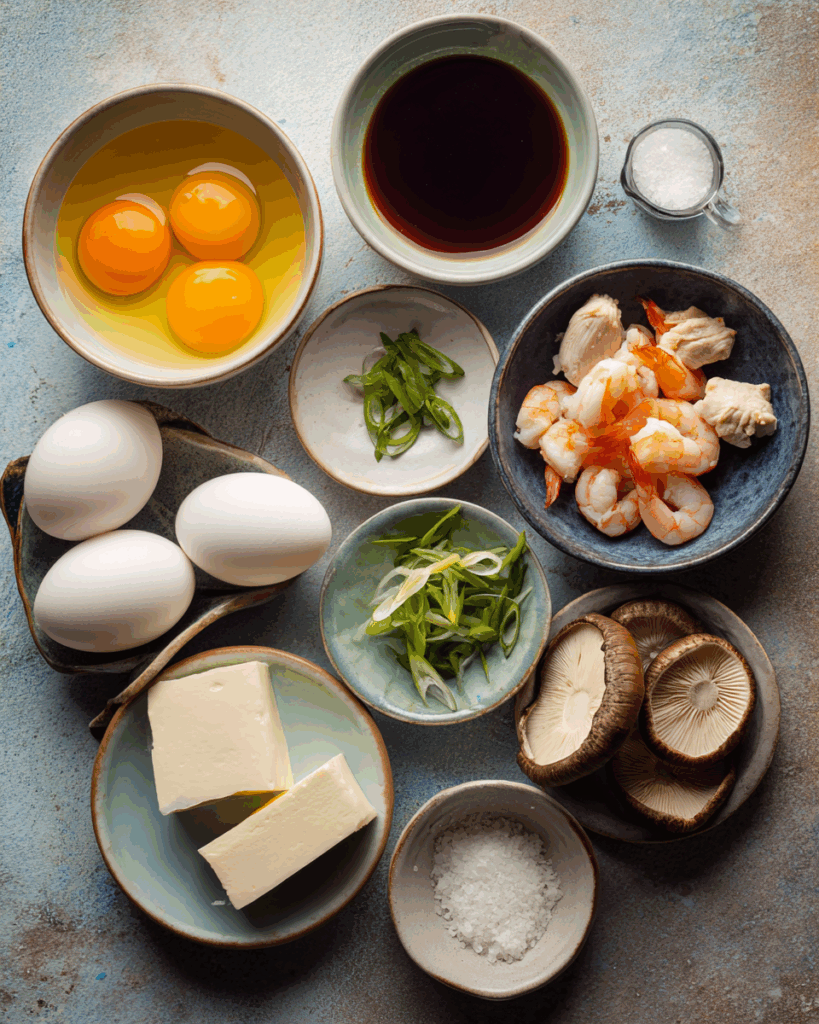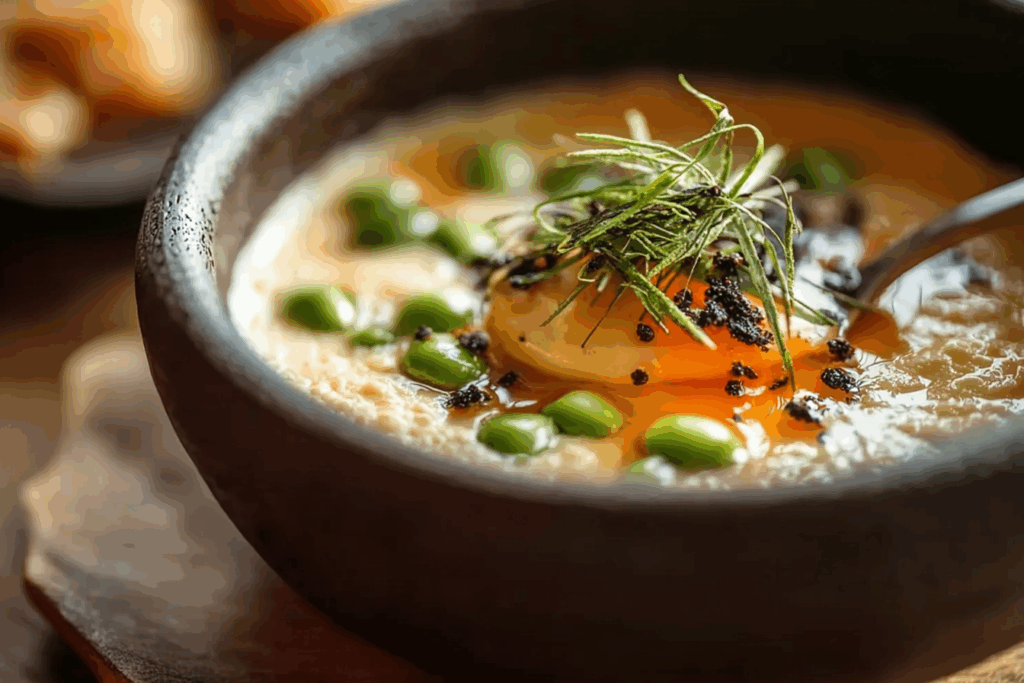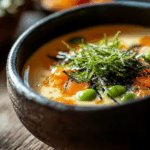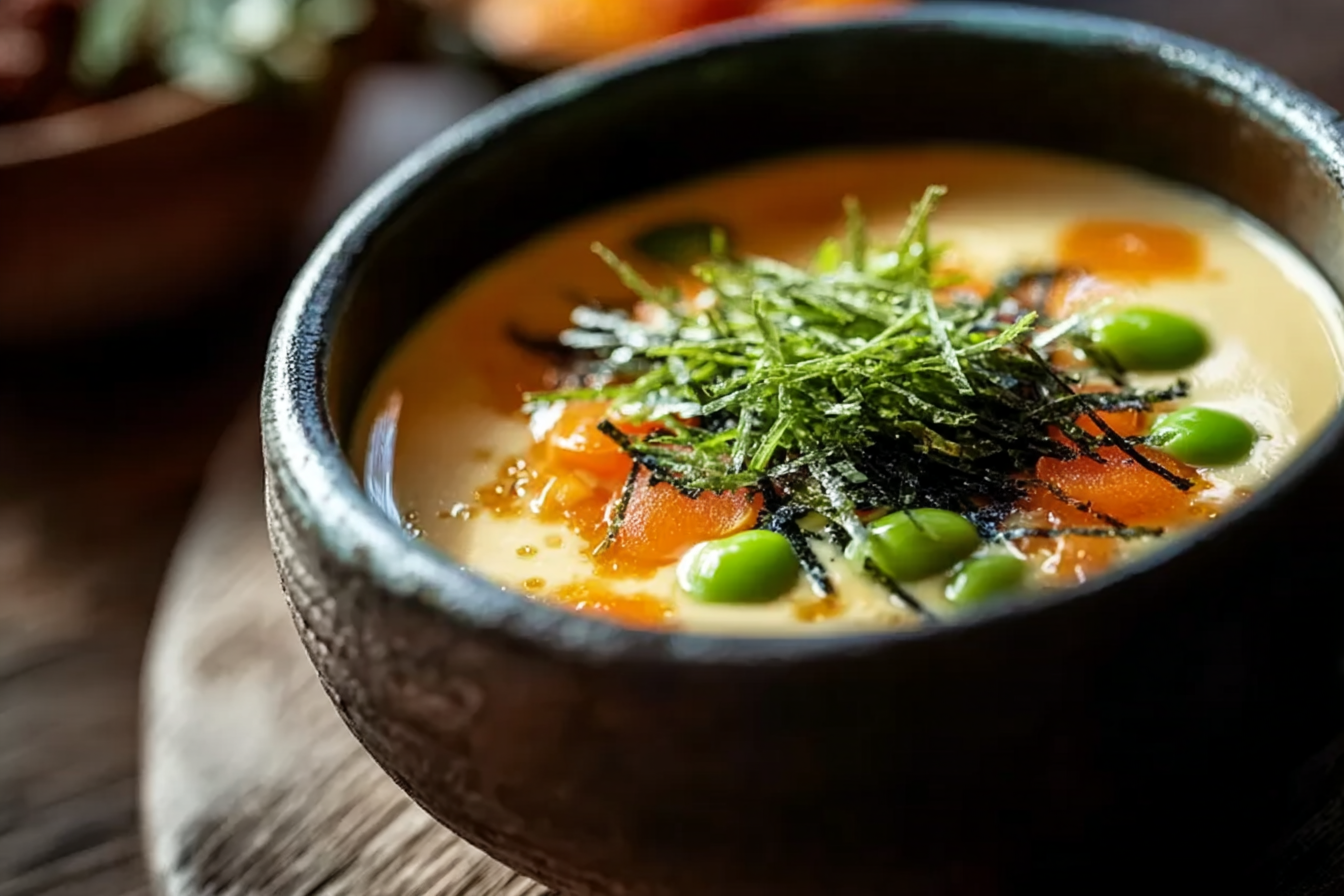There’s something undeniably comforting about the delicate texture and warmth of Chawanmushi. This Japanese steamed egg custard feels like a soft whisper of flavor, silky and subtle, carrying a quiet elegance that makes every spoonful special. The first time I made it, the steam rising from the cup smelled faintly of dashi and soy, the kind of aroma that immediately brings peace to a busy kitchen.
Behind the Recipe
Chawanmushi has always been one of those dishes that captures the essence of Japanese simplicity. It’s not flashy or overly complex, but every detail counts. The balance of flavors, the tenderness of the custard, and the harmony between ingredients like shrimp, chicken, and mushrooms make it feel almost meditative to prepare. It’s a dish that rewards patience, something that feels more like crafting than cooking.
Recipe Origin or Trivia
Originating from Japan, Chawanmushi literally means “tea cup steam.” Traditionally served as part of a kaiseki meal, it’s a savory custard that uses dashi, soy sauce, and mirin to create a light, umami-rich base. Unlike Western custards that lean toward sweetness, Chawanmushi embraces the delicate taste of the sea and earth, making it a beloved comfort dish across Japan.
Why You’ll Love Chawanmushi
This dish might look simple, but it holds layers of charm that unfold with each bite.
Versatile: You can enjoy it warm, at room temperature, or even slightly chilled, each version offering a different sensory experience.
Budget-Friendly: With just eggs, broth, and a few vegetables or proteins, this dish keeps things light on the wallet without sacrificing taste.
Quick and Easy: Once your ingredients are ready, it’s mostly about gentle steaming and waiting for magic to happen.
Customizable: Swap the proteins or add seasonal vegetables to make it your own.
Crowd-Pleasing: Its soft, smooth texture and mild flavor win over both kids and adults.
Make-Ahead Friendly: You can steam these custards ahead and reheat them gently before serving.
Great for Leftovers: They hold up beautifully for a day or two, making them a convenient treat to enjoy again.
Chef’s Pro Tips for Perfect Results
Creating that smooth, melt-in-your-mouth custard takes just a few mindful steps.
- Strain the egg mixture before steaming to remove any bubbles or strands.
- Keep your steaming temperature low and steady to avoid curdling.
- Cover the cups with foil or lids to prevent water droplets from falling in.
- Let the custard rest a few minutes before serving so the texture sets softly.
- Add your toppings lightly so they don’t sink to the bottom.
Kitchen Tools You’ll Need
Before you begin, gather the essentials that make the process smooth and enjoyable.
Mixing Bowl: For whisking the eggs and broth together.
Fine Mesh Strainer: To achieve that silky texture.
Steamer or Large Pot with Lid: For gently cooking the custard cups.
Small Cups or Ramekins: Traditionally, Chawanmushi is served in lidded tea cups.
Whisk: To mix the eggs without introducing too much air.

Ingredients in Chawanmushi
Each ingredient plays its own quiet but crucial role in this dish. Together, they create a gentle harmony of flavors.
- Eggs: 3 large eggs, beaten gently to form the custard base.
- Dashi Stock: 2 cups, the savory foundation that infuses umami flavor.
- Soy Sauce: 1 teaspoon, adds depth and saltiness.
- Mirin: 1 teaspoon, brings a touch of sweetness that balances the soy.
- Salt: 1/4 teaspoon, enhances all the subtle flavors.
- Chicken Thigh (boneless): 1/4 cup, cut into small bite-sized pieces for tenderness.
- Shrimp: 4 medium, peeled and deveined for a hint of the sea.
- Shiitake Mushroom: 1 large, thinly sliced to add earthiness.
- Kamaboko (fish cake): 4 thin slices, for color and texture contrast.
- Mitsuba or Green Onion: A few leaves, finely chopped for garnish.
Ingredient Substitutions
Cooking should be flexible, so here are some easy swaps if you’re missing something.
Dashi: Use chicken or vegetable broth with a splash of soy sauce.
Mirin: Substitute with a little sugar and rice vinegar.
Shiitake Mushroom: Try enoki or button mushrooms for a milder taste.
Shrimp: Use scallops or small pieces of white fish.
Kamaboko: A thin slice of tofu or imitation crab also works.
Ingredient Spotlight
Dashi: This umami-rich broth is the backbone of Japanese cuisine. Made from kombu (kelp) and bonito flakes, it gives Chawanmushi its subtle oceanic depth.
Eggs: The key to the custard’s smoothness lies in the gentle handling of eggs, whisked lightly to retain a delicate structure.

Instructions for Making Chawanmushi
This is a dish of calm precision, where gentleness brings out the best texture and flavor. Here’s how to bring it all together:
- Preheat Your Equipment: Prepare your steamer or pot and bring the water to a gentle simmer. Avoid rapid boiling.
- Combine Ingredients: In a bowl, lightly beat the eggs. Add dashi, soy sauce, mirin, and salt. Stir slowly to avoid creating bubbles, then strain through a fine sieve.
- Prepare Your Cooking Vessel: Place a few pieces of chicken, shrimp, mushroom, and kamaboko in each cup.
- Assemble the Dish: Pour the strained egg mixture into the cups, leaving a little space at the top.
- Cook to Perfection: Cover each cup with foil or lids. Steam on low heat for about 12 to 15 minutes until the custard is just set but still jiggly.
- Finishing Touches: Garnish with mitsuba or green onion on top for freshness.
- Serve and Enjoy: Let it rest a couple of minutes before serving. Enjoy the smooth custard, the warmth, and that gentle umami depth.
Texture & Flavor Secrets
Chawanmushi’s magic lies in its contrast, the silky custard meeting bits of tender shrimp, juicy chicken, and earthy mushrooms. The dashi base binds everything in a soft umami harmony, with soy and mirin creating a sweet-salty whisper in every bite.
Cooking Tips & Tricks
A few small tricks can make your Chawanmushi turn out perfect every time:
- Steam on low to medium heat to avoid overcooking.
- Tilt the cups slightly when pouring the egg mix to reduce bubbles.
- If the surface cracks, reduce the heat next time.
- Always strain the mixture for the smoothest custard.
What to Avoid
Even experienced cooks make small mistakes with this delicate dish.
- Don’t whisk too vigorously, it introduces air bubbles.
- Avoid high heat, it can cause the custard to curdle.
- Don’t skip covering the cups, condensation will ruin the texture.
Nutrition Facts
Servings: 4
Calories per serving: 120
Note: These are approximate values.
Preparation Time
Prep Time: 10 minutes
Cook Time: 15 minutes
Total Time: 25 minutes
Make-Ahead and Storage Tips
You can steam Chawanmushi ahead of time and store it covered in the refrigerator for up to two days. Reheat gently in a steamer or water bath until just warm. Avoid microwaving, as it may affect the smooth texture.
How to Serve Chawanmushi
Serve Chawanmushi as a starter in small cups or alongside rice and pickles for a traditional Japanese meal. Pair it with green tea for a calm, balanced experience that feels both comforting and refined.
Creative Leftover Transformations
If you happen to have leftovers, chop them into small pieces and mix with rice for a quick, savory donburi. You can also add them to a soup for a creamy, eggy touch.
Additional Tips
- Use fresh dashi whenever possible for the purest flavor.
- Warm your serving cups before pouring in the mixture to ensure even cooking.
- If you like variety, add gingko nuts or small bits of vegetables for color and texture.
Make It a Showstopper
To make your Chawanmushi look restaurant-worthy, top it with a delicate leaf of mitsuba or a small slice of yuzu peel. The contrast of colors against the pale custard creates a beautiful presentation.
Variations to Try
- Seafood Chawanmushi: Add scallops, crab, or clams for a luxurious twist.
- Vegetarian Version: Replace meat and seafood with tofu, mushrooms, and spinach.
- Spicy Fusion: Add a drop of chili oil or shichimi togarashi for a modern kick.
- Miso Infused: Stir a bit of miso into the dashi for deeper flavor.
- Winter Comfort: Add root vegetables like carrots or lotus root for a hearty feel.
FAQ’s
Q1: Can I make Chawanmushi without a steamer?
Yes, you can use a large pot with a lid and a trivet to elevate the cups above the water.
Q2: Why did my custard turn grainy?
It’s likely overcooked or steamed too hot. Keep the heat low for a smooth finish.
Q3: Can I freeze Chawanmushi?
Freezing isn’t recommended, as it alters the texture once thawed.
Q4: Can I serve it cold?
Yes, Chawanmushi can be served slightly chilled for a refreshing summer dish.
Q5: What kind of cups should I use?
Small ceramic or porcelain cups work best, preferably with lids.
Q6: How do I know when it’s done?
Insert a toothpick into the center; it should come out clean but the custard should still wobble.
Q7: Can I skip mirin?
Yes, but you can add a pinch of sugar to keep the balance of flavor.
Q8: What’s the best broth for vegetarians?
A kombu-based dashi made without bonito flakes is perfect.
Q9: Can I double the recipe?
Yes, just make sure to steam in batches so everything cooks evenly.
Q10: How do I prevent the surface from cracking?
Steam gently and cover the cups securely to control moisture.
Conclusion
Chawanmushi is one of those dishes that quietly wins hearts. It’s soft, warm, and layered with delicate flavors that feel both nourishing and elegant. Once you master the technique, you’ll find yourself making it often, not just for special occasions but whenever you crave something gentle and deeply satisfying. Trust me, you’re going to love this.
Print
Chawanmushi
- Prep Time: 10 minutes
- Cook Time: 15 minutes
- Total Time: 25 minutes
- Yield: 4 servings
- Category: Appetizer
- Method: Steaming
- Cuisine: Japanese
- Diet: Halal
Description
Chawanmushi is a traditional Japanese steamed egg custard that’s smooth, savory, and subtly flavored with dashi, soy sauce, and mirin. It’s a comforting and elegant dish often served as part of a multi-course meal, filled with delicate ingredients like shrimp, chicken, and mushrooms.
Ingredients
- 3 large eggs, beaten gently
- 2 cups dashi stock
- 1 teaspoon soy sauce
- 1 teaspoon mirin
- 1/4 teaspoon salt
- 1/4 cup boneless chicken thigh, diced
- 4 medium shrimp, peeled and deveined
- 1 large shiitake mushroom, thinly sliced
- 4 slices kamaboko (fish cake)
- 1 tablespoon chopped mitsuba or green onion for garnish
Instructions
- Prepare a steamer or large pot with a lid and bring the water to a gentle simmer.
- In a mixing bowl, lightly beat the eggs and add the dashi, soy sauce, mirin, and salt. Stir slowly to combine without creating bubbles, then strain the mixture through a fine mesh sieve.
- Place chicken, shrimp, mushroom, and kamaboko slices evenly in each serving cup.
- Pour the strained egg mixture into the cups, leaving a small gap at the top.
- Cover each cup with foil or a lid to prevent water droplets from falling in.
- Steam on low heat for about 12 to 15 minutes until the custard is just set but still jiggly.
- Remove from the steamer and garnish with chopped mitsuba or green onion before serving.
Notes
- Strain the egg mixture for the smoothest custard texture.
- Steam on low heat to prevent curdling.
- Let the custard rest for a few minutes before serving for the best consistency.
Nutrition
- Serving Size: 1 cup
- Calories: 120
- Sugar: 1g
- Sodium: 360mg
- Fat: 6g
- Saturated Fat: 2g
- Unsaturated Fat: 3g
- Trans Fat: 0g
- Carbohydrates: 2g
- Fiber: 0g
- Protein: 13g
- Cholesterol: 155mg


Bulk commenting service. 100,000 comments on independent websites for $100 or 1000,000 comments for $500. You can read this comment, it means my bulk sending is successful. Payment account-USDT TRC20:【TLRH8hompAphv4YJQa7Jy4xaXfbgbspEFK】。After payment, contact me via email ([email protected]),tell me your nickname, email, website URL, and comment content. Bulk sending will be completed within 24 hours. I’ll give you links for each comment.Please contact us after payment is made. We do not respond to inquiries prior to payment. Let’s work with integrity for long-term cooperation.